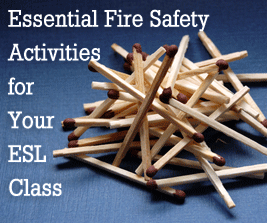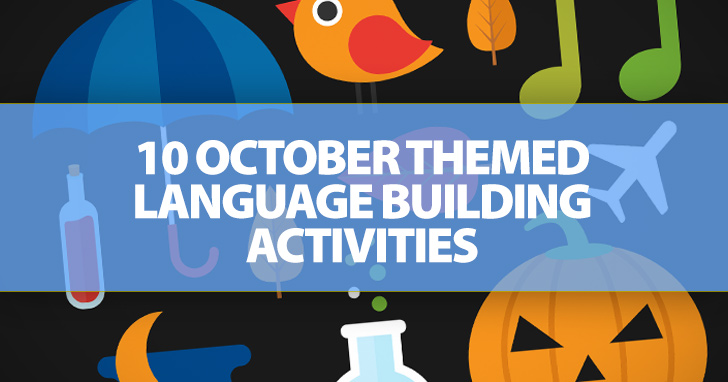Getting Serious About Fire Safety: Essential Activities for Your ESL Class


Here are some activities you can do that are just right for October.

Start the month on October 1st by celebrating the United Nation’s International Day for Older Persons. If your school is near a facility for older persons, bring your class over for a visit and some read aloud time. Your students should choose one or more books to read aloud to the older persons. Residents will especially enjoy the experience if you teach younger children. Besides serving a frequently unnoticed slice of society, your students will also get practice with their pronunciation and out loud reading.
If reading to older persons doesn’t suit your class’ personality, you can still have a good visit at this type of residence. Take your class on a field trip that will also be a listening comprehension challenge. Have students ask the residents to tell them stories from their pasts or memorable moments in history which they lived through. When you return to your own class, ask your students to share what they learned from their conversation partners.
In 2014, Fire Prevention Week is October 5-11. Invite your local fire department to your class to talk about how to prevent fires and how to be safe if you are caught in a fire. Before the visit, brainstorm vocabulary related to fire safety and fire fighters. Encourage students to take notes as your visitor presents the safety information and to listen for the vocabulary you listed before the visit. Follow the visit by having groups of three students design and publish a brochure on fire prevention, which includes the information your local fire fighter shared with your class.
Every home should have a fire escape plan, and your students’ homes are no exception. Have your students write a fire escape plan for their household. In their plans, they should include directions on how to exit from each bedroom of their home. Make sure students pay close attention to grammar as they write. How they write their escape plans is up to you. They may want to write their escape plans in the imperative structure, telling the reader what to do. They can also write their escape plans using modal verbs telling the reader what he or she should do in case of a fire.
It has been celebrated so long, no one knows the true origin of Farmer’s Day. However, people do know that October 12th is the time to support local farmers. You and your ESL class can do so while still improving and practicing language skills, speaking and listening skills to be specific. Bring your class to a local farmers’ market. Many run through the end of October or even year round. Before your trip and as a class, talk about the different types of products that can be found at a farmers market. Each one is unique, but markets often have fruits and vegetables, locally made cheese, local honey, fruit preserves, and artisan breads. Don’t be afraid to share new vocabulary with your ESL students. Also before your outing, brainstorm questions that your class might ask the vendors about their products. Then while at the market, have students go around with a partner, taking turns asking the vendors about their products. Your students will get speaking practice as they ask and listening practice as they get their answers.
Do your students watch Sesame Street? Did they watch it when they were younger? If the answer to either question is yes, then they certainly know who Oscar the grouch is. According to the popular children’s television show, October 15 is National Grouch Day, a day to celebrate grouches and their way of life. Not many of us enjoy being grouches, though. We all have bad days, but most of the time we like when someone we care about can cheer us up and improve our mood. Have your students think about different ways to bring someone from a grouchy mood into a pleasant one. Have pairs of students work together to write ten ways a person might cheer another person up. For their list, students should use various modal verbs (can, should, ought to, etc.), using stronger modals for their best ideas and weaker modals for their lesser ones. After students have their lists, ask pairs to share their best ideas with the rest of the class.
Halloween is the big October holiday, and some of your ESL students may know little to nothing about the holiday. In honor of Halloween’s costume tradition, host a speaking activity that has the same flair as a costume party. Write several costumes that a person might wear for Halloween on small slips of paper, and then tape one to each of your student’s backs so they cannot read it. Your costumes might include ghost, pirate, the president, nurse, vampire, etc. For the activity, students mingle throughout the room asking their classmates yes/no questions about themselves, trying to guess what costume they are “dressed” as. Once a person thinks she has figured out her costume, she should come to you with her answer. If she’s correct, she sits down. If she’s incorrect, she keeps mingling. Play until everyone in the class has figured out his own costume.
On October 31st, children traditionally dress in costume and go trick or treating to get candy from their friends and neighbors. What are your students’ favorite types of candy? You can play this sugary game to give your class listening comprehension and vocabulary practice. As a class, brainstorm vocabulary that you might use to describe the ingredients in a type of candy or how it tastes. Once your list is complete, each person should think about their favorite candy. He should then write five clues describing that candy without naming the candy. Have students take turns reading their clues to their classmates. The rest of the class must listen to the clues and try to guess the type of candy correctly.
Not many of us will actually encounter a monster in real life, but that doesn’t mean we can’t pretend. That’s part of the fun of Halloween. Have groups of three or four students brainstorm several different types of monsters. (You may want to allow use of dictionaries during the discussion.) Then, ask each student to choose one monster and imagine that monster was in their living room. Students should then write a conversation between themselves and the monster using correct dialogue format and punctuation. (You may want to review this before asking your students to write.) If you prefer, have pairs of students get their speaking practice in by writing a skit or dialogue between a monster and a person and then performing it for the class.
Zombies are among us, at least, that’s what Hollywood would like us to believe. Zombies are popular today in books, movies, and television shows and most often at Halloween. Have groups of two or three students work together to write a list of ten rules for surviving an attack of zombies. As students write their rules, they should use the imperative structure. Each group should make a poster illustrating their rules and then present the poster and the rules to the rest of the class. Encourage your students to be creative and come up with rules that might not seem obvious. (Get in your cardio, for example. That way you can easily outrun the zombies.) Display the posters around your classroom to keep with the holiday spirit (and as a ready resource in case of a zombie attack).